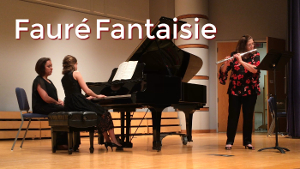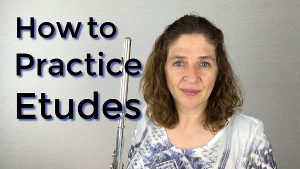We all have pesky problems in our music that are difficult to solve. We work on them and then that same problem comes back to haunt us again the next day. Do you have a method to fix these spots and more importantly, how is your method working?
Sometimes you can go over and over a section and never get anywhere. You may just need a fresh approach to help you fix it. A new method of cleaning up a spot can oftentimes be the answer you are looking for. So let me give you a few pointers about how I work on those spots that just cause me problems, the things I concentrate on, the things that I know stump me, and there are more than one.
Pesky Problems
Let me pick one spot from the Fauré Fantasy and show you how I work on it, and how I have my students work on that spot. Let’s look at measure 192. If you have your Fauré Fantasy, go get it and let’s look at the Allegro in measure 192. If you do not have it, download a free copy of it here: DoctorFlute.com/downloads. Then you can take a look at it yourself and see what I am talking about.
This spot has got so many accidentals and it moves quickly. It is arguably the most troublesome spot. It’s certainly a little bit tricky. When I have my students work on it, I show them that section and tell them to start working on it right now. It is not the only difficult spot in the piece. But this one can be a stumper.
The first thing that you’re going to do is just learn the notes. This means woodshed! If you don’t know my practice process method I’ll just give a short little rundown on that practice process. It is how I practice all of my etudes. It is how I practice all of the really tricky, fast fingering sections. I would use a modified approach to slower, more melodic sections, but this is how I practice finger technique.
The Practice Process
The first thing I am going to do is find a tempo on my metronome that I can play the section accurately. It does not matter how slow you go. You go as slow as you need to as long as you do not make a mistake.
Then you use different articulations to practice this. I like to go through all of Taffanel and Gaubert’s 10 different articulations: slur-three-tongue-one, tongue-one-slur-three, slur-two-tongue-two, tongue-two-slur-two, slur-two-slur-two etc. I will not go through all of them because you can find them. Keep the same tempo while you play through all the articulations and then slowly move the tempo up still using those articulations.
Some people think that this is a long process and well maybe it is. But let me tell you that you learn that technique cold.
Now let’s say you’ve done that. You have gotten it up to, you know, the tempo is 144. So, let’s say you have really done it well, and you are at 144… and you still have some problems. What now?
Sometimes you still have one run that just sticks, and you just can’t get it. You know, sometimes you get it right, and sometimes the next time you play through that section, it is wrong. And then the next time it is right, or another section is wrong. But you are sure that you now that technique.
Problem Solve
It can mean you have to relearn it, re-woodshed it with all those articulations and work it up again. One thing to remember is that if you have it worked up one day to a tempo, that does not mean the next day you have got it at that tempo and you do not ever have to work at it again. Over a long period of time, you are probably going to redo all those articulations. Because if we do not keep that woodshedding going and all those articulations with that metronome, we can still lose it. There is a point where our brain just stops learning. I do not know what the term is but we have to sort of take it apart and relearn it. But when you do that, you learn it better than you knew it before.
There can be other issues. Sometimes it is a glitch issue. When you take that run apart, that particular section of technique that you are having trouble with, you need to analyze: is there a glitch that is causing that problem? A glitch means that some fingers are not as fast, or they are faster than other fingers so that when you move from one note to the next, you are causing a little clunk in there. And when you do it fast, it does not really sound like a wrong note, but it just doesn’t sound smooth.
For example if you are going from a G and then you have to go to a B you have to get that thumb on. So, you are going from a high G to a B. G to a B and that thumb is not working properly. Maybe it is the thumb that was slow or the fingers coming off. Sometimes it is coming off and by analyzing what that is, you have discovered the problem. Now you can fix it. Fixing it is all about concentration. Going slow just in that little section, going very slowly, really concentrating on moving those fingers. It is a mind over matter thing. Yes, you are training your muscles. But it is also you are thinking about it that is going to fix it. Thinking about how fast they are moving.
There are times when your fingers come off too fast and they pop the sound. You want to bring your fingers up fast, but not high or jerky. Keep your fingers close to the keys, keep them touching the keys and just lift up. If we jerk them off the keys, we move them really fast, it makes the sound pop. And that is the same as having a glitch. So, unless you are doing extended techniques, that is not the sound that you are looking to get.
One other area that I think is a strong area of why we have problems, once we have learned the technique, is sometimes we are rushing. So, when I analyze, I figure out what note is rushing through, or maybe I am landing on that note ahead of the beat. I have to find out where I’m rushing or where I’m anticipating the next beat? Then I usually put maybe a tenuto line over the note so that I make sure I land on the beat. Or I’ll put an arrow going that direction so that I know that I am rushing through that run. And that helps me to remember that I need to go at tempo, not slow down. I just want to use that arrow to not rush. If I just make my eyes concentrate on that one note, I will get the rest of the run.
Concentrate
When we play our fast 16th note sections, we are not really looking at every single note. We are looking at the whole group. It is like when you read, you read the words not each letter. If I look at the word friend, I am not reading F R I E N D. I look at the whole thing and I know the word spells friend. I think that is the same way with your runs. We have learned the whole run. I know it. I do not need to read each note C D E G B. I do not need to individually think what those notes are. So, when I am playing that run, sometimes there is one note that I do need to think. I need to make sure I land on that G. Because I am looking at the group of notes as this big clump of notes. And there is one note that I am rushing through, or one note that I am not landing on.
These are just some of the areas that I use to work on difficult spots in my solos and how I have my students work on these difficult spots to make sure that when I play that solo, when my students are playing that solo, they have got that technical aspect down.
So, when you are working on your technique, find those difficult spots, use these techniques that I have just talked about and how to make sure that your runs are steady and smooth and effortless. You will be very happy that you did.
Have fun!
DoctorFlute
Watch me demonstrate this idea:
Working on those difficult spots in your solos – FluteTips 163

Fauré Fantaisie Op 79 for Flute and Piano Dr Angela McBrearty flute, Dr Gretchen Hull piano


Fixing the D to E Glitch – FluteTips 160

FluteTips 96 Are You Rushing Here’s How to Fix it


